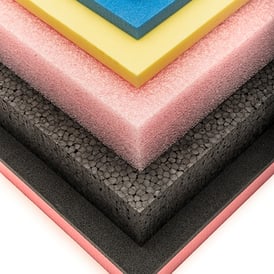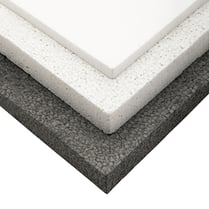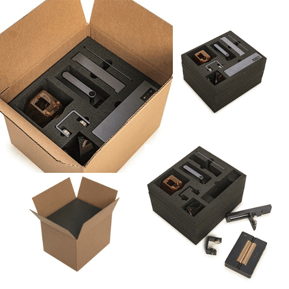Foam, an unsung hero in packaging solutions, is more than just a simple cushion for your products. Whether you are packing an item worth a fortune, or shipping a fragile keepsake, the right foam can make all the difference between it arriving intact or in pieces.
In this article, we will explore the different types of foam available for your packaging needs, and help you understand their unique properties, strengths, and potential applications.

WHICH TYPE OF FOAM WILL BEST SUIT YOUR APPLICATION?
Foam is one of the most versatile and widely used materials for protecting and cushioning products that require special handling and ultimate protection.
There are many foam types, and a wide variety of thicknesses and densities, as well as those with anti static or fire retardant properties that are available to meet your specific application.
It is vital to ensure that the foam used will be dense enough to absorb the impacts and shocks that your investment may encounter on the journey to its final destination.
The type of transportation including the class of the courier and the distance to be traveled are influential factors when selecting the type, thickness and density of foam that will best protect your product.
Foam is a cost-effective packaging solution as it is one of the most lightweight packaging materials, keeping freight costs to a minimum.
Also, almost all foam types are recyclable and reusable, it can be melted down and reused or even remolded for similar applications.
The main industrial foam used in wooden crates and large boxes is generally white or black, however, foam is available in a vast amount of colours which unquestionably assists in facilitating an unforgettable first impression.
If you are looking to line a smaller carton or plastic case with foam, brighter colors like red or blue make a bold visual statement.
Foam with fire retardant properties can be utilized in packaging applications, as well as inside electronic equipment, to protect batteries, provide vibration and shock protection for sensitive components, and many more applications including sound insulation. These foams are often used to prevent damage during transportation or storage of lithium iron batteries. These foams comply with regulations such as UL94 V-0, HF1, Mil-Spec CID-A-A-59136, as well as many other ASTM and Mil-Spec requirements.
Static protecting foam types shield sensitive components from electro-static discharge as well as physical damage, they are ideal for protecting electronic parts during storage or shipment, transporting fragile non electronic components into static controlled environments, for work in progress trays for items such as circuit boards, and more. Generally these foam types are broken into 3 different categories; conductive, anti-static and static dissipative.
Conductive, or static shielding foam, allows static charges to quickly dissipate, preventing any static build up, it is usually black in colour. It is used to create what is known as the faraday cage around a product, so that it does not have to go into a static shielding bag for the product to be appropriately protected. This is a great material for reusable solutions.
Anti-static foam is usually pink in colour, it prevents a static charge from building up when rubbed, (either by the packaged part, or another piece of foam). However, static charges can still pass through it, so to create a static free environment a static shielding bag is also required.
Static dissipative foam falls between conductive and anti-static, it allows static charges to slowly move to the ground, preventing sudden static shock from occurring.
Samples of our work and the different types of foam are available upon request
CUSTOM FOAM SOLUTIONS
SmartShield Packaging take pride in making our customers smile with packaging done right. Our dedicated team are always happy to share their product knowledge and creative expertise to assist you in achieving an exceptional package design.
With specialized equipment for cutting, shaping and gluing foam, we ensure a precisely crafted custom solution to keep your product secure at every stage of its journey.
No project is too complex for the team at SmartShield. Whether it's a simple foam insert for cushioning a single component in a cardboard box, or a sophisticated solution to protect multiple items in a plastic case, we deliver perfectly tailored packaging every time.
Presentation matters and customer satisfaction is paramount, our passion is providing you with premium packaging that will complement the item or items, and leave a lasting impression on your recipient. With a team offering skill, design creativity and years of experience, our team ensures every detail reflects quality and care.
%20(6).png?width=340&height=340&name=drone%20case%20with%20zote%20foamx%20520%20px)%20(6).png)
Here's a quick overview of the most popular foam types we offer, keep reading to find the perfect fit for your needs:
Polystyrene:

Polystyrene or EPS (expanded polystyrene) is a firm closed cell foam, also known as styrofoam. It is the most cost-effective option of all foam types.
- EPS Foam is a lightweight, rigid material, resistant to mold and bacteria and almost completely resistant to moisture, and its high thermal resistance makes it an excellent insulator.
- Higher density polystyrene offers higher strength, allowing for greater impact before being damaged.
- However due to its structure there is little vibration protection and, because it is a relatively brittle material it does not absorb shock well.
- Styrofoam is available in white and grey, and pink with antistatic properties. It is commonly used to package appliances and machine parts during transportation, or for insulation.

Polyethylene:
-1.jpg?width=207&height=207&name=POLYETHYLENE%20FOAM%20SHEETS-15(1)-1.jpg)
Polyethylene foam is a closed cell foam, its structure provides robust strength and resilience, allowing it to return to its former shape after compression.
- Polyethylene's closed cells also provide resistance to water and chemicals, preventing the growth of mold and bacteria. This rigid, lightweight foam has a high shock absorbency and provides cushioning and protection from impacts for heavy and fragile products.
- It is a shatterproof material, and its non-abrasive characteristics make it a popular packaging solution for delicate items.
- It is a cost-effective, commonly used packaging foam, similar in type to that which pool noodles are made from.
Polyethylene foam is very versatile, it comes in various thicknesses, densities and styles, and has multiple uses including insulation and packaging of large and small, heavy and light products, for a single use or a reusable package.
It usually comes in black or white and with anti-static properties in pink. It is also available with fire retardant properties. Polyethylene foam is easy to cut, glue and heat seal and, can be laminated to itself to provide thicker sections for specialized custom package designs.
-1.png?width=311&height=311&name=Untitled%20(520%20%C3%97%20520%20px)-1.png)
Polyurethane:

Polyurethane foam is an open cell foam, generally a more flexible foam than polyethylene. It is often used in custom design packaging to cushion breakable items, but also as carpet underlay or for comfort and support in home furnishings, or in the automotive industry for chair cushions.
- Polyurethane foam is cost effective and versatile, it is easy to cut and glue.
- Comes in various thicknesses and densities, in black or white and with anti-static properties in pink. It is also available with fire retardant properties.
- Can be used for insulation or to package smaller, lighter items, for a single use or a reusable package.

Is Polyethylene or Polyurethane best for your application?
Both polyethylene and polyurethane are more expensive options than polystyrene (EPS) but also more cost effective than crosslink options, if class A surface protection is not required.
Our recommendation is polyurethane for smaller, lighter product use, and its softer material characteristics are ideal for delicate items requiring higher surface protection.
While polyethylene is excellent for heavier product usage and does not absorb water due to its closed cell design.
Crosslink (XLPE):
.jpg?width=235&height=235&name=CROSSLINK-ZOTE%20FOAM%20SHEETS-17(1).jpg)
Crosslink also known as XLPE, is a closed cell foam. Polymers are chained together and heated to give it the cross-linked structure, offering superior strength and chemical properties to standard polyethylene foam.
- XLPE is a tough, long lasting and smooth, fine cell material with class A surface protection, meaning it is safe to use with painted products.
- Excellent for tool tray and case inserts solutions. It is a very clean-looking foam and durable to cleaning chemicals.
- This foam is similar to the floor matting in a gym.
- Available in many different thicknesses, densities and colors, anti-static, as well as fire retardant options are also available.
- Ideal for applications that require thicker foam, long term performance, durability and resistance to water.
%20(7).png?width=316&height=316&name=shadow%20boarding%20(520%20x%20520%20px)%20(7).png)
Zote:
Zote foam is a brand of crosslink foam so it is a closed cell, superior quality foam that also offers class A surface protection, meaning it is safe to use with painted product.
- Zote is a very high grade, durable and very light weight foam.
- Main difference between zote and standard crosslink foam is it is nitrogen expanded, meaning low odor and very consistent cell size and density, the surface of it also doesn’t mark as easily as crosslink.
- Zote may be sterilized for sanitary packaging purposes, it offers impeccable shock and vibration protection and, wears well with repeated use.
- Best option for case inserts and foam sets that are used repeatedly.
- Zote is available in many different thicknesses, densities and colors including yellow, blue, red and white.
- Also available with antistatic or fire retardant properties.

Expanded Polyethylene (EPE)
Expanded Polyethylene, also known as EPE, is another foam option to replace crosslinked foams. This material still provides class A surface protection but is easier to recycle than crosslink.
- Can also be used to replace polyethylene foam sets to reduce the overall size of a package, this is because you are able to reduce the thickness of foam around the packaged part and still provide the same protection.
- EPE is a very durable, shock absorbing, and flexible foam type and can be a great environmentally friendly replacement to standard crosslink or as a replacement for polyethylene foam to reduce the size of your package.
- This foam is available in white and black and with antistatic or fire retardent properties if required.
Final Thoughts
Understanding the various types of foam available for packaging can help you make an informed decision for your specific needs.
Whether you're after the rigidity of polystyrene, the resilience of polyethylene, or the flexibility of polyurethane, each type of foam has its unique strengths and potential applications. High-end options like Crosslink and Zote offer exceptional durability and Class A surface protection, making them the preferred choice for long-term performance and repeated use.
EPE, with its environmentally friendly profile and capacity for high shock absorption, is a compelling alternative to standard foams. With the right foam selection, you can ensure your product is protected, your package design is impeccable, and your shipping costs remain minimal.
SmartShield's commitment to premium quality and customer satisfaction means you can trust us to provide the perfect foam packaging solution for your precious products. We believe in the power of foam to safeguard your items on every step of their journey, providing the ultimate peace of mind.

.png?length=800&name=Types%20of%20foam%20(1).png)
.png?length=800&name=Types%20of%20foam%20(1).png)